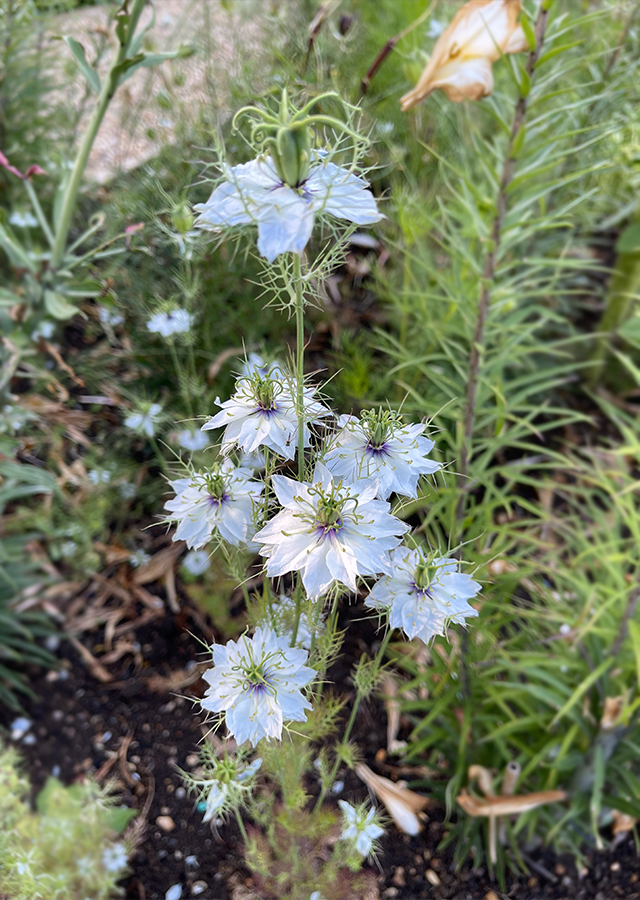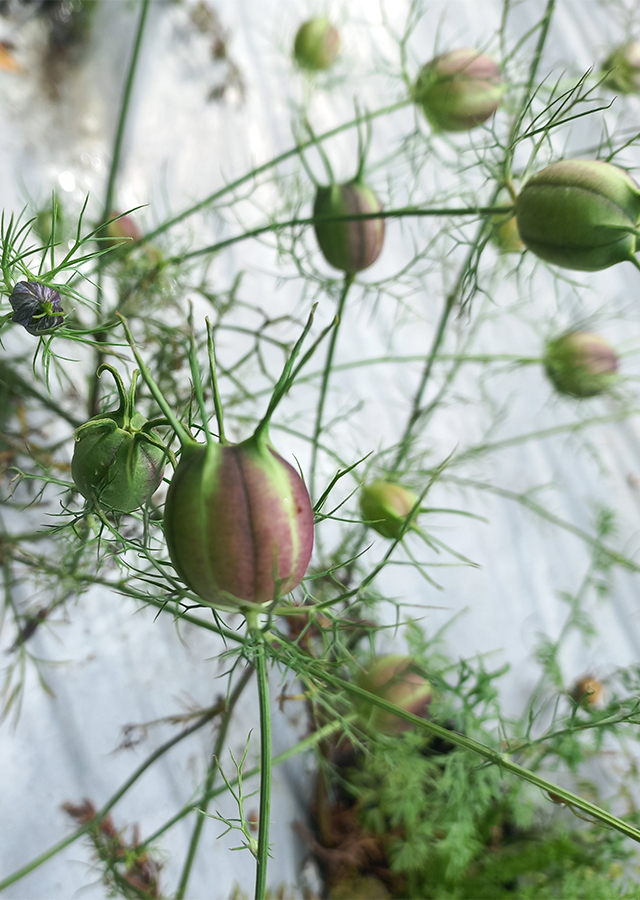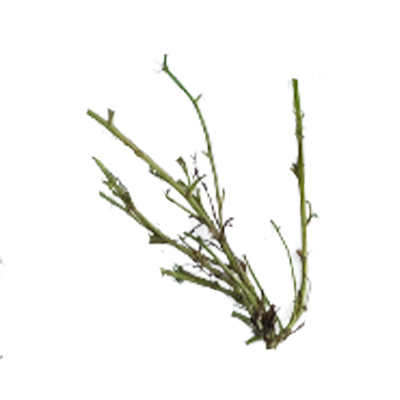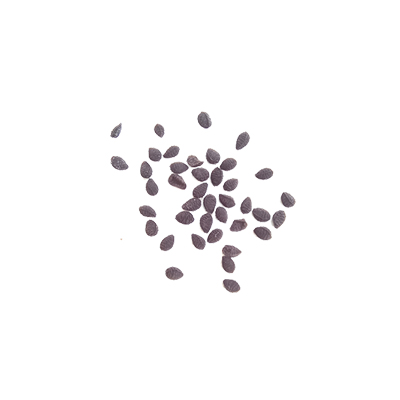Black Cumin
Nigella sativa L.
Ranunculaceae
Location in our garden
Principal



Synonym
-
Habitus
Herbaceous. An annual plant that can grow up to 0.35 m tall
Part Used
Leaves
Seeds
Stem
Growing Requirements
Full Sunshine
Habitat
Terrestrial
Overview
N. sativa is native to Southern Europe, North Africa and Southwest Asia and is cultivated in many countries in the world such as the Mediterranean region of the Middle East, Southern Europe, India, Pakistan, Syria, Turkey, Saudi Arabia. In Europe, North America and Southeast Asia it is cultivated on a small scale, mainly for medicinal purposes. In Islamic tradition, N. sativa seeds are known as a panacea. The seeds are often used as a spice in various dishes to alcoholic beverages, giving color to bread, medicine and a source of essential oils, used as a substitute for pepper. A very popular spice from the Mediterranean to India. Nigella sativa has long been used in traditional medicine in Arab countries, Far East Asia, Europe, and Africa. The plant was described as a miraculous plant and considered by the earliest herbal specialists to be a "herb from heaven". The medicinal use of black cumin seeds in various traditional herbal systems is known for various ailments.
Vernacular Names
Fennel Flower, Roman Coriander, Nutmeg Flower (English).
Agroecology
Found on waste places, arable land and waysides. Subtropical plants, can also be cultivated in temperate climates and at altitudes higher than 1,500 - 2,500 m in the tropics. Grows best in areas where annual daytime temperatures are in the 14 - 26 °C range, but can tolerate 5 - 30 °C. Easily grown in any good garden soil, preferring a sunny position. Prefers a light soil in a warm position.
Morphology
- Roots - tap root, yellow-brown.
- Stems - widely branched, subterete, ribbed, sometimes hollow when mature, pubescent, light green to dark.
- Leaves - alternate, thin sublinear leaf blade, finely divided, slightly pilose, which is usually green but sometimes turns reddish brown. The petiole is very broad at the base, light green in color, ribbed, puberulous.
- Flowers - solitary, appearing at the end of the stem (terminal), pubescent, ribbed, coral-shaped. All parts of the flower are inserted in a pale yellow receptacle, fleshy, conical in shape, visible as an orange-brown ring beneath the fruit carpel. Sepals 5, petaloid, ovate, apex blunt, tapering at base and becoming clawed (2-3 mm long), papillose to pilose, pale green when young, sometimes partially reddish, inside pale blue-white when older. Stamens in (6-)8(-10) clusters, 3-7 stamens each, each group forming a spiraloid line at the base of the flower, linear filaments, purple-blue to pale blue, anthers yellow. The pistil lobe, consisting of 3-7 white granular carpels, almost fused at the base, forms a compound ovule with a free stigma (pistil).
- Fruits - capsule ribbed, oval, tuberculous, grayish green to brown when ripe, many-seeded, with persistent stigma.
- Seeds - small, 3(-4)-sided, obpyramidal, rugose-tuberculate, dark black in color and white on the inside, smells slightly sweet and has a bitter taste.
Cultivation
Propagated by seeds - In temperate climates, black cumin begins flowering about 100 days after sowing, with mature seeds ready for harvest 50 days later. In warmer climates, flowering can begin 8-10 weeks after germination. The common spacing is (15-)25-40 cm.
Chemical Constituents
Essential oils (thymoquinone, thymohydroquinone, dithymoquinone, p-cymene, α-pinene, β-pinene, carvacrol, α-terpineol, trans-anethole, limonene, α-thujene), fatty acids (eicosenoic acid, linoleic acid, linolenic acid, myristic acid, oleic acid, palmitic acid, stearic acid), tannins, damascenine alkaloids, nigellone, nigellimine, nigellimine-N-oxide and nigellicine, campestrol, stigmasterol, β-sitosterol, α-spinasterol, alkaloids, saponins, sterols, phenolic compounds.
Traditional Medicinal Uses
- The ripe seed is anthelmintic, carminative, diaphoretic, digestive, diuretic, emmenagogue, galactogogue, laxative and stimulant.
- An infusion is used in the treatment of digestive and menstrual disorders, insufficient lactation and bronchial complaints.
- The seeds are much used in India to increase the flow of milk in nursing mothers and they can also be used to treat intestinal worms, especially in children.
- Externally, the seed is ground into a powder, mixed with sesame oil and used to treat abscesses, haemorrhoids and orchitis.
- The powdered seed has been used to remove lice from the hair.
Part Used
Reference Sources
- Royal Botanic Gardens, Kew. Plants of the World Online: Nigella sativa L.. https://powo.science.kew.org/taxon/711687-1. 24-07-22.
- Tropical Plants Database, Ken Fern. 2021. Nigella sativa. https://tropical.theferns.info/viewtropical.php?id=Nigella+sativa. 24-07-22.
- Plant Resources of South-East Asia. 2020. Nigella sativa (PROSEA). https://uses.plantnet-project.org/en/Nigella_sativa_(PROSEA). 24-07-22.
- Ebrahim M. Yimer et al. 2019. Nigella sativa L. (Black Cumin): A Promising Natural Remedy for Wide Range of Illnesses. Hindawi. Evidence-Based Complementary and Alternative Medicine. https://doi.org/10.1155/2019/1528635.
- Sultana S. et al. 2015. Nigella sativa: Monograph. Journal of Pharmacognosy and Phytochemistry, 4(4): 103-106.



